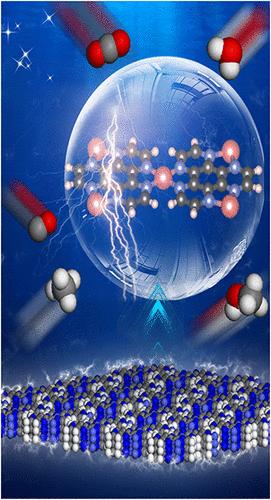Theoretical Study of Novel Two-Dimensional Conductive Metal–Organic Frameworks TM3(HAT)2 as Promising Electrocatalysts for CO2 Reduction
IF 3.2
3区 化学
Q2 CHEMISTRY, PHYSICAL
引用次数: 0
Abstract
It is vital to search for efficient CO2 reduction reaction (CO2RR) electrocatalysts for synthesizing value-added targeted products. In this work, by using density functional theory (DFT) calculations, we systematically investigated the electrocatalytic CO2RR performance of the novel two-dimensional (2D) conductive metal–organic framework (MOF) TM3(HAT)2 monolayers (TM = Ti, V, Cr, Mn, Fe, Co, Ni, and Cu; HAT = 1,4,5,8,9,12-hexaazatriphenylene). The CO2RR catalytic activity of the designed catalysts is highly correlated with the d-electron number of TM active sites. Co3(HAT)2 is found to be the most promising CO2RR catalyst with a calculated limiting potential (UL) value of −0.23 V for the CH4 product, followed by Ni3(HAT)2 toward both the CH4 and CH3OH products (UL = −0.34 V). Moreover, the thermodynamic and electrochemical stability simulations suggest that the screened-out Co3(HAT)2 and Ni3(HAT)2 with high activity are also with good stability. Importantly, these two catalysts could inhibit the competitive hydrogen evolution reaction, further demonstrating their high activity and selectivity for the CO2RR. The results not only contribute to the search for efficient CO2RR electrocatalysts that are used in high-value fuels but also shed light on the opportunities to explore electrochemical applications based on 2D conductive MOFs.

新型二维导电金属-有机骨架TM3(HAT)2作为CO2还原电催化剂的理论研究
寻找高效的CO2还原反应(CO2RR)电催化剂是合成高附加值目标产品的关键。在这项工作中,通过密度泛函理论(DFT)计算,我们系统地研究了新型二维(2D)导电金属-有机框架(MOF) TM3(HAT)2单层(TM = Ti, V, Cr, Mn, Fe, Co, Ni和Cu; HAT = 1,4,5,8,9,12-六氮杂苯)的电催化CO2RR性能。所设计的催化剂的CO2RR催化活性与TM活性位点的d电子数高度相关。Co3(HAT)2是最有前途的CO2RR催化剂,对CH4产物的极限电位(UL)计算值为- 0.23 V,其次是Ni3(HAT)2对CH4和CH3OH产物的极限电位(UL = - 0.34 V)。此外,热力学和电化学稳定性模拟表明,筛选出的高活性Co3(HAT)2和Ni3(HAT)2也具有良好的稳定性。重要的是,这两种催化剂可以抑制竞争性析氢反应,进一步证明了它们对CO2RR的高活性和选择性。该结果不仅有助于寻找用于高价值燃料的高效CO2RR电催化剂,而且还为探索基于二维导电mof的电化学应用提供了机会。
本文章由计算机程序翻译,如有差异,请以英文原文为准。
求助全文
约1分钟内获得全文
求助全文
来源期刊

The Journal of Physical Chemistry C
化学-材料科学:综合
CiteScore
6.50
自引率
8.10%
发文量
2047
审稿时长
1.8 months
期刊介绍:
The Journal of Physical Chemistry A/B/C is devoted to reporting new and original experimental and theoretical basic research of interest to physical chemists, biophysical chemists, and chemical physicists.
 求助内容:
求助内容: 应助结果提醒方式:
应助结果提醒方式:


